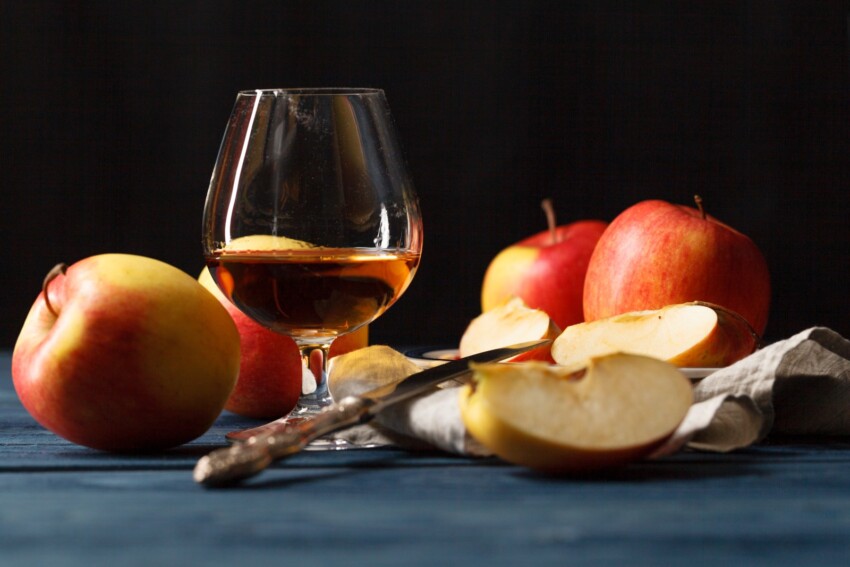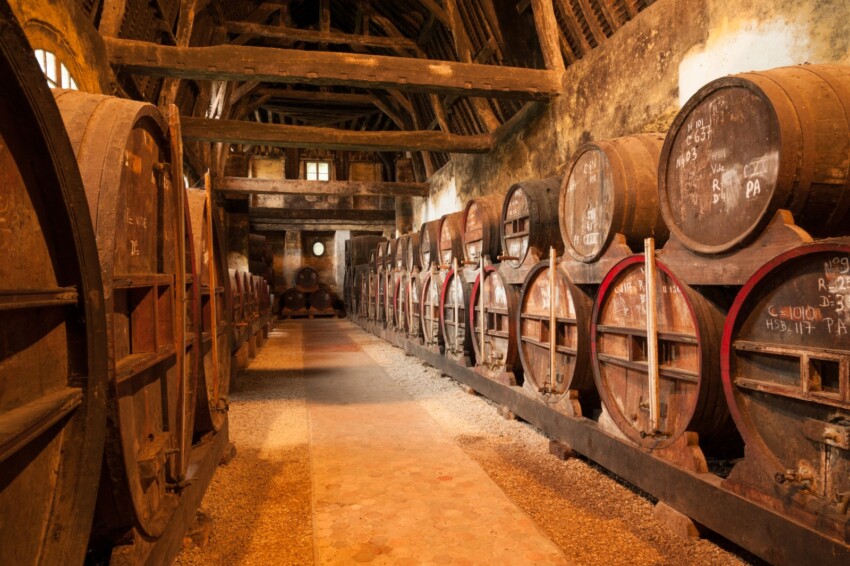

Calvados is one of Normandy’s gastronomic delicacies: it is known internationally as one of the world’s most famous and appreciated spirits .
This particular spirit is obtained from the distillation of apple cider and is produced exclusively in theFrench department of the same name, Basse-Normandie, in Northern France, using only local, exquisitely Norman apples.
Calvados has been awarded theAppellation d’origine contrôlée (AOC) appellation of controlled origin, which includes three different types.
This is perhaps the most prized variety of Calvados, awarded the status of premiere cru: it is produced in very few areas of the region, with a long and elaborate process. In fact, the fermentation of the cider lasts at least six weeks and the cider, once distilled, must remain in oak barrels to age from 6 to 10 years.
The designation rewards the quality of the raw materials and also of the instruments, such as the famous Charentaise stills, which guarantee a slower distillation that respects the aromas.
To this appellation belong the cider productions that take place in certain areas of Normandy: Calvados, Mayenne, Sarthe, Eure-et-Loir, Orne and part of Eure. They cover about 70% of the entire production.
This type takes two years of ageing in oak barrels and special, regulated apple varieties are used.
Domfrontai refers to the distillate that uses the fermentation of both apples and pears (minimum 30% pears): the cider thus obtained will be of mixed fruit, which must in any case come from specific areas of Calvados and Normandy.
To buy Calvados from Normandy, you have two options: you can go there and buy it in one of the many local wine shops and distilleries, or, if you are at home, you can monitor the offers that are periodically promoted on Amazon. Below are some excellent bottles available online.










There are more than 100 different types of apples cultivated in the inland areas of Calvados. The most common in the production of Calvados cider are Duret, Saint-Aubin and Bendor . These types are characterised by a high tannin content and good acidity.
What makes Calvados so special and distinctive is undoubtedly the ideal mix of apples, which belong to all four categories: by skilfully blending them, the perfect level of acidity, essential for proper storage, the right amount of sugar, essential for fermentation, and the unmistakable flavour that gives the cider a unique blend of taste and aroma.
The apples are pressed and fermented for a period of at least one month, rising to 6 months for Calvados Pays d’Auge.
At this stage of processing, the cider has an alcohol content of 5%: it must rest for a year before moving on to the distillation stage.
Distillation, which is strictly regulated by the AOC, varies according to the Calvados appellation. Classic Calvados, for example, involves a double distillation, while Calvados Domfrontais a distillation in double-column copper stills . In this case, the result is a white cider with a strong apple flavour and a light amber colour.
On the other hand, Calvados Pays d’Auge requires a compulsory double distillation, carried out in traditional stills: the cider thus obtained will have a rich and complex flavour.
The last stage of production is ageing in oak barrels, which will add woody notes to the spirit.
The number of years it takes to rest in barrels varies according to the quality of the cider: a good quality aged Calvados is recognisable by its dark golden colour with orange and red highlights. The flavour will also be unmistakable: much less fruity, decidedly drier and more aromatic depending on the length of ageing.
Calvados is normally enjoyed at the end of a meal, served at a temperature of 16-18 C°.
In restaurants, it is often used for the trou Normand, or Normand hole: in Normandy, it is customary to drink a small glass of Calvados between two particularly substantial courses, often accompanied by an apple sorbet, to aid digestion and continue the meal by renewing the appetite.

One of the experiences to try on a trip to Normandy, is to savour Calvados, combining its intense apple aroma with a taste of sweets, preferably fruit, with spicy notes of cinnamon and vanilla.
Not everyone knows, however, that France’s most famous cider also goes very well with the intense Norman Livarot cow’s milk cheeses: or with Pont l’Eveque cheese or Andouillette smoked salami, produced in Cambrai, in north-eastern France.
Only true connoisseurs will venture into the difficult pairing with first and second course preparations : the combination can be tried for instance with ‘ Poulet a la Normanne‘ cooked with mushrooms and apples. In these cases, a 2-year young Calvados or a white, i.e. unaged, Calvados is recommended, where the fruity aromas stand out greatly, since they have not yet been blurred by the hint of wood.
White Calvados is also served as a digestive, like white grappas in Italy.
The French cider spirit was already known in the time of Charlemagne, when Brittany and Normandy were among the few French regions where distilleries were not subject to penalties and heavy taxation.
The heyday for cider distillate production was in the 19th century, when industrial distillation resulted in the widespread diffusion of the liqueur not only on French soil but also across the Channel in England.
The distillate became so famous and widely used that it was supplied as a comfort drink to soldiers during the Second World War.